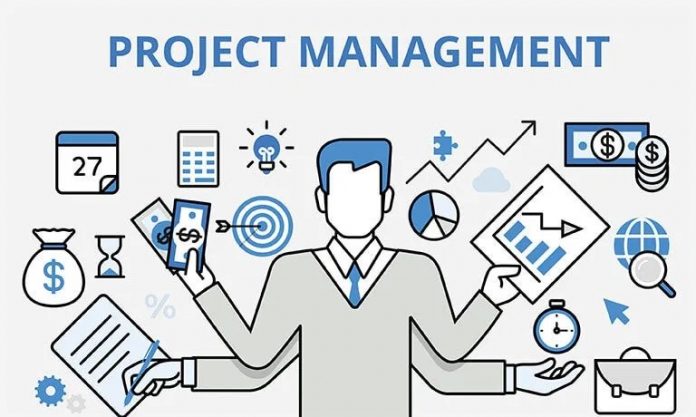
Project management in simple words-
Project management is a way a person manages resources that are necessary to complete a project. It has needed for maintain the budget and timescale. It involves planning and organizes of a company recourse to move a specific project completion. Project management concept is often used with fields in engineering, health care and IT. It is no matter what the industry is the project manager has the same job to help archive the goals. They also have responsibility for checks quality control of completed work to ensure the standard. The project management includes the process of planning, execution, monitoring, Closing of projects. Every project needs to plan that outlines how it will be built and finish.
Every project usually has a budget and a time limit. Project management keeps everything to move smoothly. When the planed time project manager keeps all the team members to finish on schedule.
Types of Project Management
-
Waterfall Project Management
This is best on the traditional project management but it includes a process that each task needs to be completed before the next one starts. Because of this, sequences and timelines are very important in this type of project management.
-
Agile Project Management
This methodology first use in the computer Software industry. It organizes with the 12 core principle of the Agile Manifesto, It is iterative process management focused on the continues Improvement of deliveries.
Agile project management does not follow any stage- by – stage approach, it follows parallel to each other by various team members. This approach can find and rectify errors without restart the whole work.
-
Lean Project Management
This methodology is about both waste of time and resources. Japanese manufacturing practices introduce the principle of this methodology, the main idea behind this approach to create more value for customers.
-
Scrum Project Management
Scrum is a small brief of agile. It is fast but very small in scope. Scrum is used to accomplish the project into small pieces. It is great for smaller teams that are iterating quickly.
-
Kanban Project Management
Kanban is another same as agile project management. It is focused on all about an organization. It looks at the number of tasks that go into the process and how the can be finished. This is a great model for those who don’t any factory-like output
-
Lean Project Management
Lean management as the same as Kanban project management. This management is based on all about the process but it has an even emphasis on trimming the fat. It is focusing on a mindset of customer get first preference and to deliver the best, most affordable for customers.
-
Six Sigma Project Management
The Six Sigma method focused on improving the output quality of a project. This is helpful if you choose a lean management style and found the result less than satisfactory. This method can be merged on other management styles and it is a great way to refine.
-
PRINCE2 Project Management
Private sectors often use PRINCE2 method. It focuses on minimize risks and errors. This method detailed focused on chucking projects up into project-based steps.
When I give someone for project or assignment help and they tell me “that’s a lot of work”, my response is “How do you know it’s a lot of work when you haven’t done any of it yet?”
― Robert J. Braathe
5 stages of project management
-
Project Initiation
A Project started initially with its name during this phase at a board level. Feasibility studies are conducted depending on the nature of the project. It may require, in an IT project-requirement gathering are performed in this phase. Behalf of a Construction industry project charter is completed in this phase. Important stakeholders made in this phase to help decide if the project is going forward or not. If there is a green signal move to the next label of this phase “Requirements gathering of the project”. During the requirements gathering activity, mainly the client requirements are gathered. After analyzing the information certain requirements are changed or removed.
-
Project Planning
Project planning is one of the main steps of project management processes. In this phase, the team of the project management team gets any wrong decision it gives a negative impact on the next phases. This phase begins generally to archive goals. In this process, the project requirements like requirements scope, budget, and timelines. Depending on the budget schedule and resources are allocated to the project. Depending on the budget and schedule, resources are allocated to the project. Team leaders allocating resources and team members focused on their tasks. S.M.A.R.T and CLEAR are more popular goal-setting methods follow in the phase.
-
Project Execution
This phase is most common in the project management system. This Phase mainly focuses on the satisfaction of the customer with a good delivery process. Through the project execution a lot is happening, like update status reports, team meetings and performance reports. During the project execution, many reports have to be made. The management team of the company is responsible for daily or weekly status updates on the progress. In addition to reporting, there are deliveries to be made. Instead, the deliveries there are many scattered throughout
During the Execution of the project these tasks completed:
- Develop team
- Assign resources
- Status meetings
- Modify project plans
-
Control and validation
The project activities should be thoroughly controlled and validated during the project life cycle process. The controlling of the project can be done mainly based on some initial protocols such as project plan, quality test for the project. Sometimes, such protocols have made the instance that is not covered. The Project manager should use the necessary steps to control the situations. Validation is the most supporting activity that belongs from the first day to the last of a project. Every activity should be validated for successful outcomes or completion. When any project delivery or requirement has come, a ‘quality assurance team’ calls to assist the team for validation.
-
Closeout and Evaluation
When any project is complete, it is time to hand over to Client and closeout the project. After that, the project will be accepted and paid by the customer. Once the project time to closeout, it is time to evaluate the entire project. In this process, any mistakes made by the project team will be identified and will take the necessary steps to avoid them in future projects.










